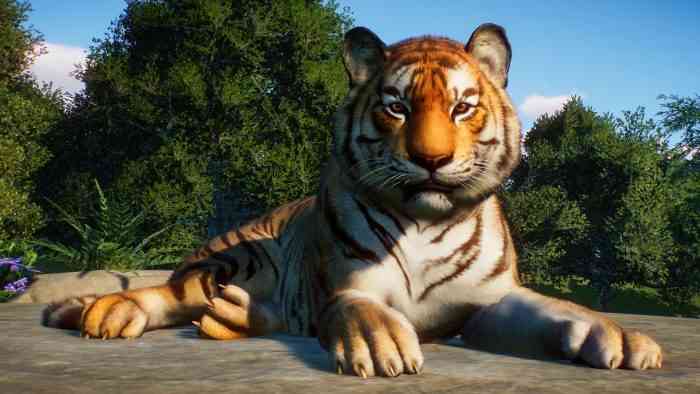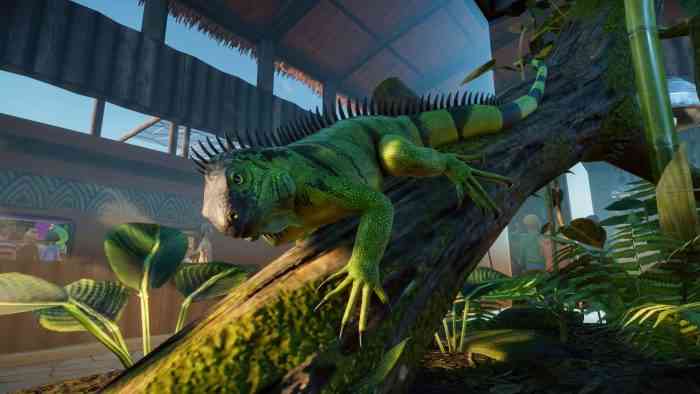Planet Zoo Review
I’ll never forget the day I killed my first animal. It was a day that felt like any other; full of hectic demands and frantic clicking in every direction to try to make every cog in my machine run smoothly and self-sufficiently. He was a Japanese Macaque named Hiroyuki, and through what felt like no fault of my own, I could not keep him fed.

Maybe I’m just the worst zoo owner on the face of the Earth, or maybe this is just as common an experience for other players as it seems to be for me in Planet Zoo. You’ve got so many people to keep happy that often you have to make the choice between putting guest needs on the backburner and focusing on animal welfare, or sacrificing one for the other in the opposite direction. Sometimes you simply can’t figure out where you’re going wrong. Of course, it would be nice to have everything work out in perfect unison, but such is almost never the case in this massive, sometimes punishing, construction and management simulation game by Zoo Tycoon and Planet Coaster’s Frontier Developments.
Planet Zoo follows the same formula as any other management sim out there, but rather than solely running a business where you have to meet guest demands and maintain employee morale while staying in the black, there’s the extremely significant added factor of the welfare of the animals you are basing your business around. Planet Zoo allows you to buy, sell and release animals into the wild and create the zoo of your dreams in one of the most powerful and detailed simulations ever made. It’s a gorgeous achievement that tackles issues related to wildlife endangerment and environmental education, and while it does an excellent job bringing animals and the management experience to life, at some times it feels almost a little too big for its britches.
Many Ways to Play
Planet Zoo offers four major gameplay modes: Career, Franchise, Challenge and Sandbox. Career mode starts off with a couple of tutorials that teach you basic construction and mechanics before following up with different scenarios and objectives you can progress through, and even though I didn’t find it especially fun to jump into already-built zoos, the mode is definitely necessary to help you wrap your head around how the game works. Though the tutorials walk you through many topics, I wouldn’t expect it to completely hold your hand through every crucial aspect of the game. Regardless of whether you play through the tutorials or not, the overwhelming majority of your first few days with Planet Zoo will be spent just figuring things out — and frankly, being downright confused for much of it.

Franchise mode is an online mode that has you open and operate brand new zoos around the globe, with an emphasis on breeding and trading animals with other players. I enjoyed this mode the most for its great blend of building freedom and objective structure, but I found that the Animal Trading center where you buy and sell animals was a bit of a crapshoot. Being at the mercy of what other players are offering to the table means that sometimes the market will have a bajillion Western Lowland Gorillas up for grabs, but potentially very few other species to choose from. Challenge mode is similar to Franchise except that it offers different objectives offline, and Sandbox allows you to build to your heart’s content without money or guest happiness being an issue.
While initially, I thought Sandbox mode would be my bread and butter, I found it to be the least interesting of all the available modes. Building can be so frustrating and open-ended (a subject that deserves both praise and criticism in Planet Zoo — but more on that later) that stripping away all of the other things that make the game — well, a game — took away all purpose from even playing. In its current state, it’s not possible to adjust the starting amount of money or the level of animal enrichment items that have to be researched over a long period of time, so without anything to work towards at all or any customization to the Sandbox scenarios, the only thing left to do is truly just build for the sake of building.
Where Did I Go Wrong?
Planet Zoo requires an extreme level of micromanagement between guest, employee and animal happiness. There’s a deep level of consciousness that has to go into every thought and decision you make, and in hours and hours of play with the game, I never quite figured out how to balance the scales in all three directions at the same time. On one hand, my animals need feeding so I don’t run into another Hiroyuki disaster, so I need to place my zookeeper’s hut close to the exhibit so he/she doesn’t commute too far and waste precious time. I can’t place it too close, though, because then all my guests will be grumpy that their zoo experience is being ruined by seeing the staff facilities out in the open. This isn’t just one aspect of the game, it’s every aspect. Guests will always be pissed that they don’t have a good enough view of the animals, or that they can see staff buildings, or that the park as a whole doesn’t offer enough stimulation to them. Animals need space, high-quality food and toys for stimulation, and the correct male-to-female ratio in their enclosures. I can’t even begin to understand what my employees want, because sometimes just getting them to flat out do their job feels enough like pulling teeth, let alone investigating why they are happy or not.
Planet Zoo has so many vastly different components to factor in and so much attention required in so many areas that getting the park to run smoothly on its own for even a second feels damn near impossible. Many times, you are not offered enough information to even grasp all of the mechanics, and other times certain snags in the game go unexplained. My panda bears, for example, kept continuously getting boxed up while in their enclosure, and I had to keep releasing them when the game deigned to notify me that my pandas were getting miserable because they had been boxed up for hours. I could not, for the life of me, figure out what was going wrong in their enclosure that they kept getting scooped up by the game and plopped back at the entrance of their pen.

To this day, I am still perplexed by issues like this, and I’m not convinced whether it’s my own stupidity and oversight, or whether the lack of help offered in the game is the reason for my small failures. I am still perplexed why I have a consistent stream of alerts that my animals are starving when I have more than enough staff and facilities to accommodate them. Is it because I haven’t placed enough feeders in the enclosures to keep up with the appetites of my animals? Is it because my staff is getting stuck somewhere along the way, or because they are incompetent? Am I incompetent?
I’ve had my fair share of confusion in Planet Zoo, and I know that some of it must be my own human error, but I also feel that certain mechanics are overly complicated for no reason. For example, many animals desire plants in their enclosures to make them feel more at home. When you click on individual animals, you can see what continent they are from and what biome they are used to (Grassland, Tropical, Tundra, etc.) Naturally, you should place plants that share these exact same characteristics and the animals will be happy, right? Wrong. You have the option to filter plants by continents and biomes, but even then you may place one down to find that the animal claims the plant is not from the same continent as them. Why they apply the filtered tags and then still offer incorrect plant options is beyond me, and it leads to a lot of unnecessary clicking and deleting that could have been easily streamlined if the system just worked.

Staying Afloat
The business aspect of Planet Zoo can be very unforgiving and takes a lot of finesse to work through. I can’t even count the amount of times I had to start a brand new zoo from scratch because I botched my previous one within minutes. Let’s just say I learned a lot of things the heard way. I learned that you have to start out with lower-profile animals such as tortoises and peafowls just to stay afloat with the cost of their food, and you can’t let the complaints of guests saying there’s not a lot to see or do in your zoo get the best of you. You definitely can’t go too big too fast; guests are just going to have to wait when it comes to that drink shop they wanted, or you’re going to have to hold off on the big, beautiful African grassland exhibit you wanted to build. When it comes to management sims, this is one of the hardest ones to keep your head above water in and turn enough of a profit to expand. You have to have miles of patience and the desire to take your time and expand slowly. Unless you are in Sandbox mode, expanding quickly is an extremely difficult task, and any slightly wrong decision can put your profits under.
In terms of building, Planet Zoo is the be-all-end-all of construction possibilities. If you can think it, you can pretty much build it, so long as you have the patience. For talented builders and creative geniuses, Planet Zoo offers a boundless world of resources and options, and for that it deserves high praise. However, for simpletons like myself who appreciate building but don’t necessarily have the greatest knack (or even just the energy or grit for it), your zoo will most likely be a primitive place devoid of right angles or walls that actually connect perfectly to one another.
While I admire the endless amount of freedom you have with building and creating, I also lose my mind at times with how unnecessarily complicated the controls can be. I’m puzzled by why there are no simple click-and-drag mechanics with pathways and barriers, because adjusting the length of each individual piece in meters gets old really fast. Surface snapping with cosmetic items such as signs or vertical ivy bushes can be so frustrating it’s not even worth doing most of the time. Perhaps the most irritating mechanic of them all is the “grouping” mode, where placing individual walls or roofs or doorways snap to one another to become a group — a mechanic that’s essentially only useful if you’re making perfect squares or rectangles. God forbid you have a misshapen area you’re trying to build a wall around, because then you have to keep exiting the group and placing each individual piece over and over again to prevent snapping. Just forget about placing shorter walls or pieces to fit your perimeter or having wall pieces connect to one another if you are working outside of traditional rectangular formations.

Sky’s The Limit
If it sounds like I am knocking Planet Zoo, I don’t mean to be. If anything, my scrutiny comes from a place of how much time and energy I’ve put into the game, and the insecurity from how few times I’ve actually launched a fully successful zoo. Though the micromanagement required and the realistic and dynamic needs of all the animals creates stress at times, it’s not necessarily bad stress. Planet Zoo does an amazingly beautiful job in terms of performance and pure aesthetics, and the realism of the animals is an absolute joy to witness. Maybe the rub of it all is that in terms of management, it’s too realistic, and the choices you make have too much of an impact. If you slack on researching a certain one of your animal species and fail to provide them with enrichment items or better quality food, protesters will show up at your zoo with pickets and megaphones. If you sacrifice the guest experience entirely for the welfare of the animals (i.e. giving the animals too much privacy and pissing off your guests who can’t get a good view), you’ll fail to keep your business afloat.
Despite the frustrations that Planet Zoo causes from the sheer amount of content in the game, it should also be celebrated. To have such a gorgeous and detailed Zoo Tycoon descendant that satisfies the years-long craving I had to run my own zoo in the new age is a dream come true, and the sky is really the limit in this game.
Planet Zoo is perfectly suited for an animal lover, a talented builder and an endlessly patient player who enjoys taking their time and being meticulous. For pure simulation lovers, this is going to be stressful to wrap your head around. It feels like more micromanagement is required than in any other game because you’re worrying about animals, employees and guests, and it can feel impossible sometimes to figure out where you’re going wrong. No amount of tutorial will make you feel prepared for what this game requires to be successful, and more often than not you will run your zoo into the ground within the first hour. However, it is undeniably a beautiful achievement that seamlessly ties together wildlife education and environmental consciousness, and the emotional attachment you will create with your animals makes for an engaging simulation unlike any other.
***PC review code provided by the publisher.***
The Good
- Absolutely breathtaking visuals
- Colossal in size, content and freedom
- Educational and meaningful message
The Bad
- Overly complicated mechanics and controls
- Requires a ton of patience
- Difficult to figure out why things go wrong
- R.I.P Hiroyuki

